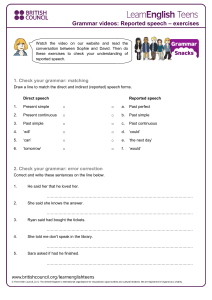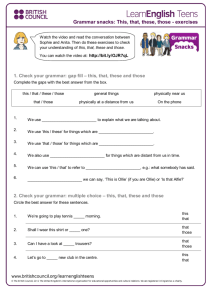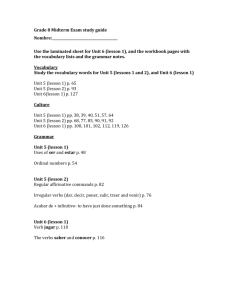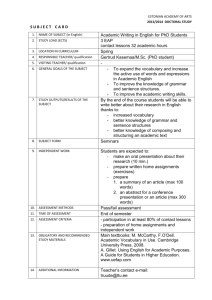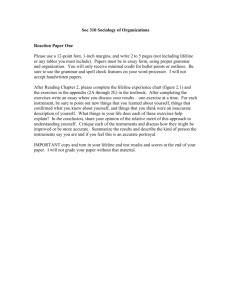Sixth Grade - Bridgedale Academy
advertisement
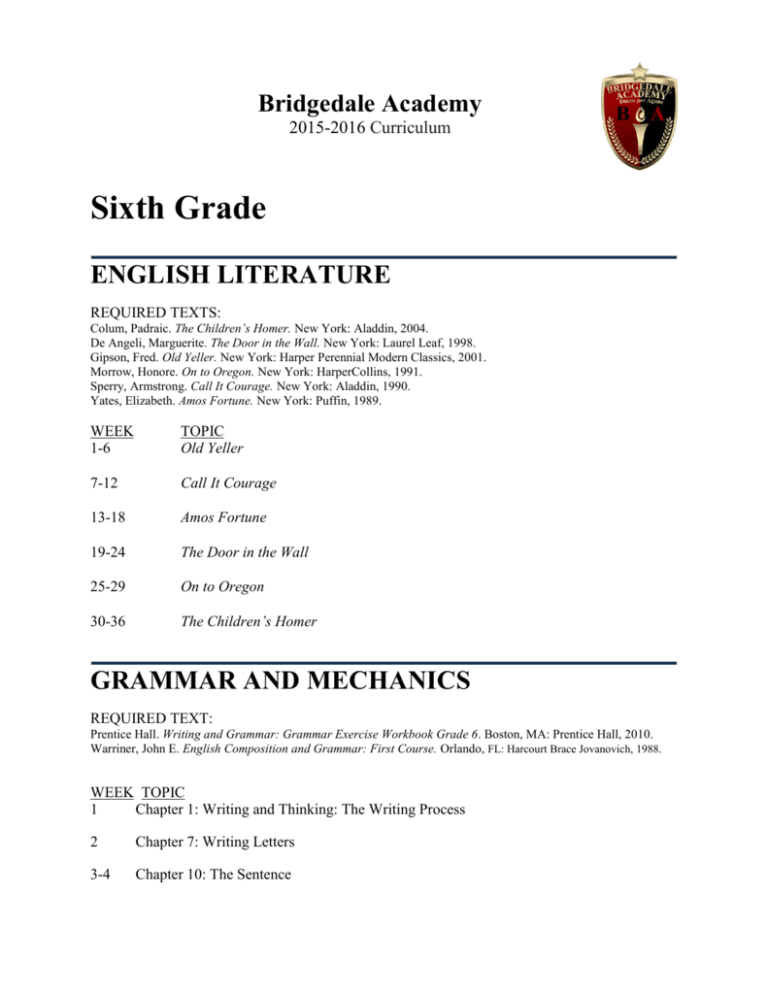
Bridgedale Academy 2015-2016 Curriculum Sixth Grade ENGLISH LITERATURE REQUIRED TEXTS: Colum, Padraic. The Children’s Homer. New York: Aladdin, 2004. De Angeli, Marguerite. The Door in the Wall. New York: Laurel Leaf, 1998. Gipson, Fred. Old Yeller. New York: Harper Perennial Modern Classics, 2001. Morrow, Honore. On to Oregon. New York: HarperCollins, 1991. Sperry, Armstrong. Call It Courage. New York: Aladdin, 1990. Yates, Elizabeth. Amos Fortune. New York: Puffin, 1989. WEEK 1-6 TOPIC Old Yeller 7-12 Call It Courage 13-18 Amos Fortune 19-24 The Door in the Wall 25-29 On to Oregon 30-36 The Children’s Homer GRAMMAR AND MECHANICS REQUIRED TEXT: Prentice Hall. Writing and Grammar: Grammar Exercise Workbook Grade 6. Boston, MA: Prentice Hall, 2010. Warriner, John E. English Composition and Grammar: First Course. Orlando, FL: Harcourt Brace Jovanovich, 1988. WEEK TOPIC 1 Chapter 1: Writing and Thinking: The Writing Process 2 Chapter 7: Writing Letters 3-4 Chapter 10: The Sentence 5-6 Chapter 11: Nouns, Pronouns, Adjectives 7-8 Chapter 12: Verbs, Adverbs, Prepositions, Conjunctions, Interjections 9-10 Chapter 17: Agreement 11-12 Chapter 22: Capital Letters 13-14 Chapter 2: Writing Paragraphs: Structure and Development 15-16 Chapter 8: Writing Complete Sentences 17-18 Chapter 13: Complements 19-20 Chapter 14: The Phrase 21-22 Chapter 15: The Clause 23-24 Chapter 18: Using Verbs Correctly 25-26 Chapter 23: Punctuation: End Marks, Commas, Semicolons, Colons 27-28 Chapter 3: Writing Paragraphs: Four Types of Paragraphs 29-30 Chapter 9: Writing Effective Sentences 31-32 Chapter 16: The Kinds of Sentence Structure 33 Chapter 19: Using Pronouns Correctly 34 Chapter 20: Using Modifiers Correctly 35 Chapter 24: Punctuation: Italics, Quotation Marks, Apostrophes, Hyphens 36 Chapter 21: Glossary of Usage VOCABULARY REQUIRED TEXT: Hodkinson, Kenneth and Sandra Adams. Wordly Wise 3000, Book 7. Cambridge, MA: Educator's Publishing Service, Inc., WEEK TOPIC 1-2 Lesson 1, Exercises A-E, Test 1 3-4 Lesson 2, Exercises A-E, Test 2 5-6 Lesson 3, Exercises A-E, Test 3 7-8 Lesson 4, Exercises A-E, Test 4 9-10 Lesson 5, Exercises A-E, Test 5 11-12 Lesson 6, Exercises A-E, Test 6 13-14 Lesson 7, Exercises A-E, Test 7 15-16 Lesson 8, Exercises A-E, Test 8 17-18 Lesson 9, Exercises A-E, Test 9 19-20 Lesson 10, Exercises A-E, Test 10 21-22 Lesson 11, Exercises A-E, Test 11 23-24 Lesson 12, Exercises A-E, Test 12 25-26 Lesson 13, Exercises A-E, Test 13 27-28 Lesson 14, Exercises A-E, Test 14 29-30 Lesson 15, Exercises A-E, Test 15 31 Lesson 16, Exercises A-E, Test 16 32 Lesson 17, Exercises A-E, Test 17 33 Lesson 18, Exercises A-E, Test 18 34 Lesson 19, Exercises A-E, Test 19 35-36 Lesson 20, Exercises A-E, Test 20 SPELLING REQUIRED TEXTS: Woodruff, G. Willard and George N. Moore. Working Words in Spelling, Level G. Boston, MA: D.C. Heath & Co., 1998. WEEK 1 TOPIC Lesson 1 2 Lesson 2 3 Lesson 3 4 Lesson 4 5 Lesson 5 6 Lesson 6, Review 7 Lesson 7 8 Lesson 8 9 Lesson 9 10 Lesson 10 11 Lesson 11 12 Lesson 12, Review 13 Lesson 13 14 Lesson 14 15 Lesson 15 16 Lesson 16 17 Lesson 17 18 Lesson 18, Review 19 Lesson 19 20 Lesson 20 21 Lesson 21 22 Lesson 22 23 Lesson 23 24 Lesson 24, Review 25 Lesson 25 26 Lesson 26 27 Lesson 27 28 Lesson 28 29 Lesson 29 30 Lesson 30, Review 31 Lesson 31 32 Lesson 32 33 Lesson 33 34 Lesson 34 35 Lesson 35 36 Lesson 36, Review PENMANSHIP SUGGESTED TEXTS: Zaner-Bloser. Handwriting: A Way to Self-Expression, Grade 8. Columbus, OH: Zaner-Bloser 1991. Zaner-Bloser. Handwriting: Book 6. Columbus, OH: Zaner-Bloser, 2003. WEEK 1-2 TOPIC Unit 1: Getting Started 3-12 Unit 2: Writing in Cursive 13-24 Unit 3: Using Cursive Writing 25-36 Continued Practice SPANISH I REQUIRED TEXTS: Text Book: All Bilingual Press, LLC – Espanol para chicos y grandes Second Edition Level 1 – Rita Wirkala Grammar and Exercises Manual: All Bilingual Press, LLC - Rita Wirkala WEEK TOPIC 1 Alphabet Trying words with accent mark and pronunciation Asking names and spelling Introducing yourself Grammar and Vocabulary 2 Greetings friends, classmate and adults appropriately, asking how they feels Expressing feelings Saying Good bye Grammar and vocabulary 3 Naming Spanish speaking countries Learning continents and nationality Grammar and vocabulary 4 Numbers Key Questions Asking phone numbers Grammar and vocabulary 5 Colors Identifying colors Using feminine and masculine adjectives Grammar and vocabulary 6 Identifying things around the classroom Using here, there and other locations Describing objects around the classroom Grammar and vocabulary 7 Introducing personal pronouns Introducing basic verbs and conjugations Using basic statements 8 Days of the week Asking about weekly events Talking about weekly appointments Grammar and vocabulary 9 Talking about Christopher Columbus More numbers Asking for and indicating time, including hours, half hours, quarter hours and minutes 10 Asking and saying when certain events are scheduled Talking about appointments Months of the year Grammar and vocabulary 11 Identifying weather Talking about climate and seasons Grammar and vocabulary 12 Animals Describing animals Grammar and vocabulary 13 Identifying family Describing family members Talking about Family birthdays and events 14 Review of family members Introducing other relatives Grammar and vocabulary 15 Body Parts Introduction to daily activities Reading and comprehension about daily activities 16 Talking about food and beverages Identifying Breakfast, Lunch, Snack and Dinner Grammar and vocabulary 17 Review of food and beverages Saying you are hungry and Thirsty Offering food and drinks Grammar and vocabulary 18 Introducing things and objects on the table Talking about what it is for? Grammar and vocabulary 19 Review of food, beverage and table Identifying food in the grocery store Asking how much is it? Grammar and vocabulary 20 Identifying beverages Ordering beverages and food in a food stand and restaurant Special project 21 Clothing Latin American clothing ( boys and girls) Talking about sizes Grammar and vocabulary 22 My House Identifying rooms Grammar and vocabulary 23 Review of my house Identifying and describing furniture and appliances Reading and comprehension 24 My Town Discovering around town Likes and dislike around town 25 Asking directions Describing buildings and transportation Grammar and vocabulary 26 Going shopping Review of asking in the store Review of clothing, size and color Review asking for prices 27 Commands Reading and comprehension Grammar and vocabulary 28 What do we have to do…? Daily activities 29 Making a Calendar Review events, times, appointments and daily routines 30 Talking about Easter 31 Introduction of present progressive Expressions More vocabulary 32 What he is / she is doing? Grammar and vocabulary 33-36 Create a presentation or performance Choosing a famous person This project will review the entire lessons - Name - Brief biography - Why you are choosing this person - Why he / she is famous - Major accomplishment - Why he / she is famous - Major accomplishment HISTORY & GEOGRAPHY REQUIRED TEXTS: Hakim, Joy. A History of US: An Age of Extremes, 1880-1917. New York: Oxford University Press, 2002. -----. A History of US: War, Peace, and All That Jazz, 1918-1945. New York: Oxford University Press, 2002. -----. A History of US: All the People, 1945-1999. New York: Oxford University Press, 2002. WEEK 1 TOPIC From Hakim, A History of US: An Age of Extremes, 1880-1917 Chapter 1: Carnegie 2 Chapter 2: A Bookkeeper name Rockefeller Chapter 3: Mr. Storyteller 3 Chapters 4: Powerful Pierpont 4 Chapter 5: Monopoly: Not Always a Game 5 Chapter 6: Builders and Dreamers 6 Chapter 7: Lady L Chapter 8: Presidents Again 7 Chapter 9: The People's Party Chapter 10: Making Money 8 Chapter 11: Hard Times 9 Chapter 12: Gold & Silver 10 Chapter 13: A Cross of Gold 11 Chapter 14: Some Bad Ideas 12 Chapter 15: Producing Goods 13 Chapter 16: Harvest at Haymarket 14 Chapter 17: Workers, Labor (And a Triangle) 15 Chapter 18: Rolling the Leaf in Florida 16 Chapter 19: Catching the Day 17 Chapter 20: Telling it Like it is Chapter 21: Bread and Roses, Too 18 Chapter 22: The Fourth Estate 19 Chapter 23: Ida, Sam, and the Muckrakers 20 Chapter 24: A Boon to the Writer Chapter 25: In Wilderness is Preservation 21 Chapter 26: The Gilded Age Turns Progressive 22 Chapter 27: Teedie 23 Chapter 28: From Dude to Cowboy 24 Chapter 29: The Spanish American War 25 Chapter 31: Teddy Bear President Chapter 32: Jane Addams, Reformer 26 Chapter 33: Henry Ford Chapter 34: The Birdmen 27 Chapter: 35: William Howard Taft 28 Chapter 36: A Schoolteacher President 29 Chapter 37: War - WWI 30 Chapter 37: WWI - continued From Hakim, A History of US: War, Peace, and All That Jazz, 1918-1945 Chapter 1: War's End 31 Chapter 2: Fourteen Points 32 Chapter 15: The Prosperity Balloon Chapter 16: Getting Rich Quickly 33 Chapter 17: Down and Out (The Great Depression) 34 Chapter 25: President Roosevelt (FDR) Chapter 26: Twentieth-Century Monsters (Preview WWII) 35-36 Final Projects: WWII SCIENCE TEACHER RESOURCES: The science curriculum is guided by the Delta Science Modules. There are no texts for the student. Each module’s teacher guide contains worksheets for the student. DELTA SCIENCE MODULES: Plants in Our World. Hudson, NH: Delta Education, Inc., 1996. DNA: From Genes to Proteins. Hudson, NH: Delta Education, Inc., 1994. Earth Processes. Nashua, NH: Delta Education, Inc., 1994. Matter and Change. Hudson, NH: Delta Education, Inc., 1996. Newtons Toy Box.Hudson, NH: Delta Education, Inc., 1996 Astronomy. Hudson, NH: Delta Education, Inc., 1999. SUPPLEMENTAL RESOURCES:* Maton, Anthea, et al. Exploring Physical Science. Upper Saddle River, NJ: Prentice Hall, 1997. -----. Dynamic Earth. Upper Saddle River, NJ: Prentice Hall, 1997. -----. Parade of Life: Monerans, Protists, Fungi, and Plants. Upper Saddle River, NJ: Prentice Hall, 1997. Exploring the Universe. Upper Saddle River, NJ: Prentice Hall, 1997 Padilla, Michael, et al. Cells and Heredity. Upper Saddle River, NJ: Prentice Hall, 2000. *Each Prentice Hall text is used to supplement the Delta Science Module units. A teacher’s edition is available for each one of the student texts listed. WEEK TOPIC From Plants in Our World, supplemented by material in Parade of Life: Monerans, Protists, Fungi, and Plants 1 Distinctions Between Plant and Animal Cells; “Plant and Animal Cells” Plant Stems; “Plant Stems: Structure and Function, Part 1” Plant Stems; “Plant Stems: Structure and Function, Part 2” Effect of Light and Water on Seedling Growth; “What Do Plants Need? Part 1” 2 Field Trip: Observe plant types and collect samples of algae in lakes and moss in woods Transpiration; “Stomata and Transpiration, Part 1” Transpiration; “Stomata and Transpiration, Part 2” Effect of Light and Water on Seedling Growth; Phototropism; “What Do Plants Need? Part 2” 3 Photosynthesis—Intake of Carbon Dioxide; “Plants Take in Gas, Part 1” Photosynthesis—Intake of Carbon Dioxide; “Plants Take in Gas, Part 2” Photosynthesis—Production of Oxygen; “Plants Give Off Gas, Part 1” 4 Photosynthesis—Production of Oxygen; “Plants Give Off Gas, Part 2” Chlorophyll as Green Pigment; “Paper Chromatography” Photosynthesis—Production of Starch; “Plants Make Food, Part 1” 5 Photosynthesis—Necessity of Chlorophyll; “Chlorophyll” Plant Respiration-Production of Carbon Dioxide; “Cellular Respiration in Plants, Part 1” Plant Respiration-Production of Carbon Dioxide; “Cellular Respiration in Plants, Part 2” 6 Photosynthesis—Production of Starch; “Plants Make Food, Part 2” Starch and Glucose in Plants; “Plants Store Food” Importance and Uses of Plants; “The Uses of Plants” 7 Assessment Review (Part 1) Assessment Review (Part 2) Assessment Sections 1-2 8 Assessment Section 3 and Homework Section Return and Discussion of Assessment From DNA: From Genes to Proteins, supplemented by material in Exploring Physical Science 9 Features, Characteristics and Variations; “How Do I Look?” Relation of Proteins to Variations; “Proteins and Appearances” Structures and Their Functions in Cells; “What’s in a Cell?” Modeling a Cell; “Modeling a Cell” 10 Modeling Genetic Material in the Nucleus; “What’s in the Nucleus?” Modeling DNA; “Modeling DNA” Replication of DNA; “Replicating DNA” Transcription; RNA from DNA; “Modeling a Message” 11 Protein Synthesis; Transcription and Translation; “The Code Makes a Product” Protein Synthesis; Transcription and Translation;“The Code Makes a Product” (cont'd) Genes, Chromosomes and Mutations; “Genes and Mutations” Bacteria and Viruses; “Simpler Cells” 12 Extraction of DNA; “Extra Experiment” Transplanting Genes; DNA Recombination; “How We Use DNA in Cells” DNA Fingerprinting; Human Genome Project; “DNA Fingerprinting” Film, “Voyage into the Cell” 13 Assessment Review (Part 1) Assessment Review (Part 2) Assessment Sections 1-2 Assessment Section 3 and Homework Section Return and Discussion of Assessment From Earth Processes and supplemented by material in Dynamic Earth Continental Drift 14 Continental Drift; Sedimentary Rock Samples; “Pieces of a Puzzle” (continued) Model of Earth and Its Interior Igneous Rock Samples; “The Structure of the Earth” Composition of Earth’s Crust; Weathering 15 Metamorphic Rock Samples; “The Earth’s Weathered Crust, Part 1” Formation of Sedimentary Rocks; “Sediments Become Rocks, Part 1” Formation of Igneous Rocks; Model Volcano; “Volcanoes Make Rocks, Part 1” Completion of Three Activities; “The Earth’s Weathered Crust, Part 2” 16 “Sediments Become Rocks, Part 2” “Volcanoes Make Rocks, Part 2” Review of Earth Processes; Practice in Identifying Rock Samples Formation of Metamorphic Rock; Interactions of Sedimentary, Igneous and Metamorphic 17 Rocks; “The Rock Cycle” Modeling Mountain Formation; “Mountain Building” Modeling Compressional and Shear Waves in Earthquakes; “Earthquake!” Model Seismograph; Richter Scale; “Building a Seismograph” 18 Plotting Locations of Earthquakes and Volcanoes; “Ring of Fire” Isostasy; “A Balancing Act” Modeling Convection Currents in Earth’s Mantle; “Convection Currents” Modeling Ocean-Floor Spreading; “The Ocean Floor” 19 Connection Between Crustal Plate Movement and Continental Drift; “Plate Techtonics” Assessment Review (Part 1) Assessment Review (Part 2) Assessment Sections 1-2 20 Assessment Section 3 and Homework Section Return and Discussion of Assessment From Matter and Change and supplemented by material in Exploring Physical Science 21 Density of Liquids Pressure/Volume of a Gas Delta Reader 22 Solutions and Suspensions Atomic Structure Making Molecules 23 Ionic and Covalent Compounds Chemical Equations Isomers 24 More Organic Compounds Acids and Bases Neutralization 25 Oxidation Precipitates Delta Reader 26 Assessment Review (Part 1) Assessment Review (Part 2) Assessment Review (Part 3) 27 Homework Session and Discussion Review and Prepare for Test Test/Final Assessment From Newton’s Toy Box and supplemented by material in Exploring Physical Science Newton’s First Law of Motion; “Motion in Review” The Force of Gravity; “Gravity and Balance” 28 Newton’s Second Law of Motion; “Moving Masses” The Force of Air Resistance; “The Parachute Drop” Parabolic Trajectories; “Basketball Arcs” Parabolic Motion; “Ball and Cup Contest” 29 Average Speed; “Rolling On” Average Speed; Gravitational Potential Energy; Kinetic Energy; “Great Race” Acceleration; “Accelerating Masses” Elastic Potential Energy; Energy Conservation; “The Come-Back-Can” 30 Newton’s Third Law of Motion; “Action-Reaction in Action” Newton’s Third Law; Potential and Kinetic Energy; “The Grasshopper Game” Momentum and Its Conservation; “Clacker Conservation” Assessment Review (Part 1) 31 Assessment Review (Part 2) Assessment Sections 1-2 Assessment Section 3 and Homework Section Return and Discussion of Assessment From Astronomy and supplemented by material in Exploring the Universe 32 Modeling Hourly Movement of Sky Objects; “The Sky in Motion” Movement of Sky Objects; “The Sky in Motion” (continued) 33 Modeling Sky and Rotating Earth; “As the Earth Turns” View of Sky Related to Latitude Astrolabe and Solar Quadrant; “Skies Around the World, Part 1” Sky View Related to Latitude; “Skies Around the World, Part 2” 34 Monthly Movement of Sky Objects; “Stars Throughout the Year” Movement of Sun Through Constellations and the Seasons; “The Sun and Seasons” Model of Stonehenge and the Seasons; “The Sun and Seasons” (continued) Solar System Scale Model; “Planet Watch” 35 Modeling Positions of the Planets; “Planet Watch” Identifying Starfields and Matching with Constellations; “Constellations and Myths” Myths of Constellations; “Constellations and Myths” (continued) Three-Dimensional Model of Big Dipper; Stellar Distances; “Three-Dimensional Starfield” 36 Lenses, Telescopes and Magnification; “Seeing More” Stages of Stellar Evolution; “Life Cycle of a Star” Discussion of Handout “Cycles” (from Astronomy) Classification of Galaxies; Counting Galaxies; “Galaxies” Probability of Other Life in Universe; “Are We Alone?” Assessment Review (Part 1) Assessment Review (Part 2) Assessment Sections 1-2 Assessment Section 3 and Homework Section Return and Discussion of Assessment MATHEMATICS REQUIRED TEXT: Hake, Stephen and John Saxon. Math 8/7: An Incremental Development. Norman, OK: Saxon Publishers, Inc., 2004. WEEK TOPIC 1 Lesson 1: Arithmetic with Whole Numbers and Money 2 Lesson 2: Properties of Operations; Sequences 3 Lesson 3: Missing Numbers in Addition, Subtraction, Multiplication, and Division 4 Lessons 4-5: Number Line; Integers; Place Value through Hundred Trillions; Reading and Writing Whole Numbers 5 Lessons 6-7: Factors; Divisibility; Lines and Angles 6 Lesson 8: Fractions and Percents; Inch Ruler 7 Lesson 9: Adding, Subtracting, and Multiplying Fractions; Reciprocals 8 Lesson 10: Writing Division Answers as Mixed Numbers; Improper Fractions 9 Lessons 11-12: Word Problems about Combining and Separating; Word Problems about Comparing and Elapsed Time 10 Lessons 13-14: Word Problems about Equal Groups; Word Problems about Parts of a Whole 11 Lesson 15: Equivalent Fractions (Part 1) 12 Lesson 15: Reducing Fractions (Part 1) 13 Lesson 16: U.S. Customary System 14 Lessons 17-18: Measuring Angles with a Protractor; Polygons; Similar and Congruent 15 Lessons 19-20: Perimeter; Exponents; Rectangular Area (Part 1); Square Root 16 Lesson 21: Prime and Composite Numbers; Prime Factorization 17 Lesson 22: Fraction-of-a-Group Problems 18 Lessons 23-24: Subtracting Mixed Numbers with Regrouping; Reducing Fraction (Part 2) 19 Lesson 25: Dividing Fractions 20 Lesson 26: Multiplying and Dividing Mixed Numbers 21 Lesson 27: Multiples; Least Common Multiple; Equivalent Division Problems 22 Lessons 28-29: Two-Step Word Problems; Average (Part 1); Rounding Whole Numbers; Rounding Mixed Numbers; Estimating Answers 23 Lesson 30: Common Denominators; Adding & Subtracting Fractions with Different Denominators 24 Lessons 31 & 33: Reading and Writing Decimal Numbers; Comparing Decimals; Rounding Decimals 25 Lesson 34: Decimal Numbers on the Number Line 26 Lesson 35: Adding, Subtracting, Multiplying, Dividing Decimal Numbers 27 Lessons 37 & 40: Area of a Triangle; Rectangular Area (Part 2); Sum of the Angle Measures of a Triangle; Angle Pairs 28 Lesson 41: Evaluating Expressions; Distributive Property 29 Lesson 42: Repeating Decimals 30 Lesson 43: Converting Decimals to Fractions; Converting Fractions to Decimals; Converting Percents to Decimals 31 Lessons 44-45: Division Answers; Dividing by a Decimal Number 32 Lesson 46: Unit Price; Rates; Sales Tax 33 Lesson 48: Fraction, Decimal, Percent Equivalents 34 Lesson 52: Order of Operations 35 Final Projects 36 Final Projects
